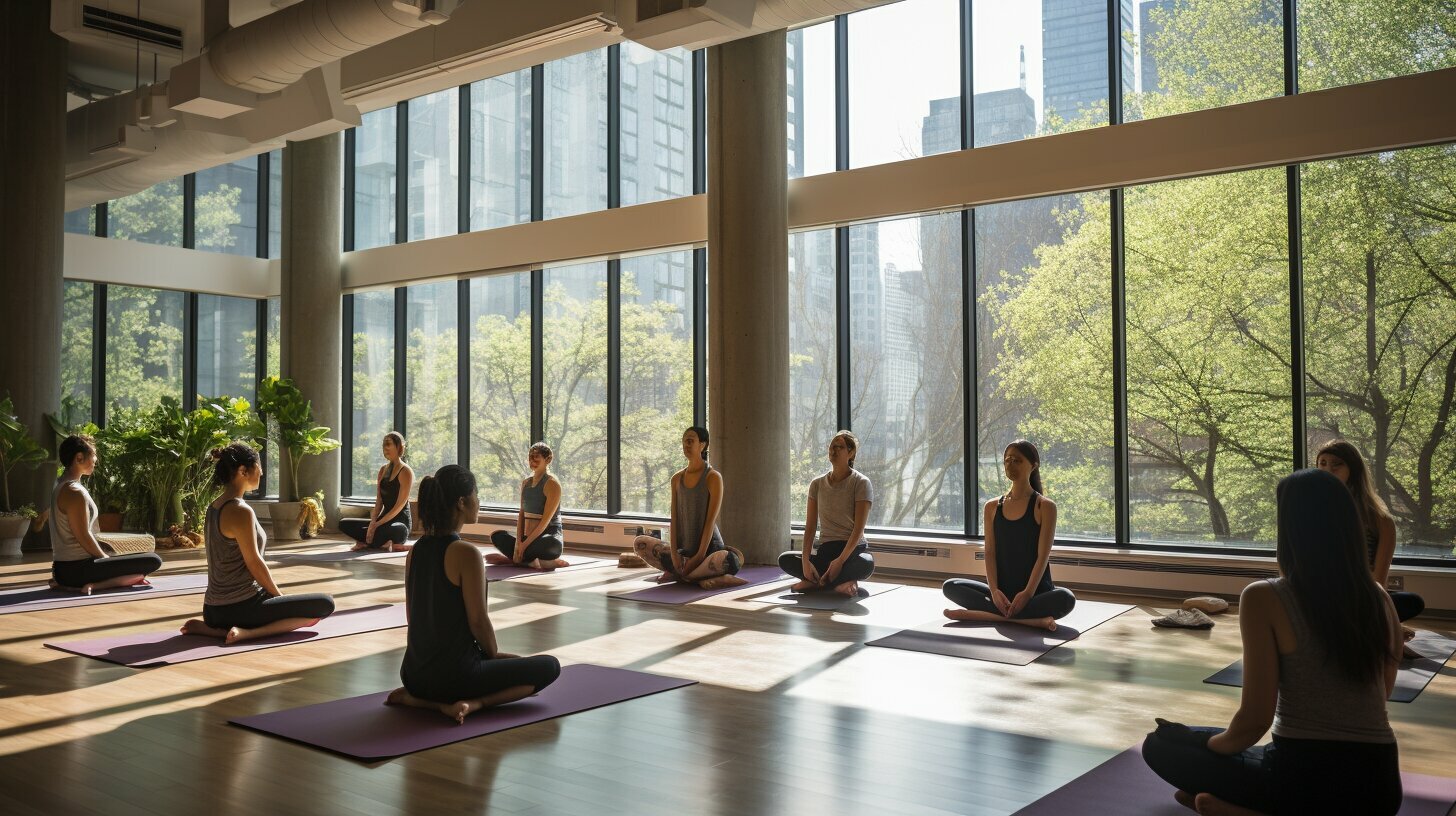Yoga has become increasingly popular in recent years, and many people are looking to take their passion for yoga to the next level by starting their own classes. If you’re one of them, you may be wondering where to begin. Starting your own yoga class can be a daunting task, but with the right guidance and resources, you can make your dream a reality.
In this comprehensive guide, we’ll take you through the steps required to start your own yoga class, from understanding the basics of yoga to marketing and promoting your services. You’ll also learn how to develop your teaching skills, set up your yoga space, manage finances and legal considerations, and expand your yoga business.
- Starting your own yoga class requires passion, knowledge, and dedication
- Understanding the basics of yoga, developing your teaching skills, and creating a peaceful environment are essential for success
- Effective marketing and building strong student relationships are crucial for attracting and retaining students
- Managing finances, legal considerations, and continuing education are important for long-term success
- Expanding your yoga business through workshops, retreats, and online classes can open up new opportunities
Understanding the Basics of Yoga
Welcome to the world of yoga! Before starting your own yoga class, it’s essential to understand the basics of this ancient practice.
Yoga is a mind-body practice originating from ancient India, which involves physical postures, breathing techniques, and meditation. The philosophy behind yoga is to unite the body, mind, and spirit, promoting overall health and wellbeing.
There are various styles of yoga to choose from, each with its unique benefits and focus. Some of the popular styles include:
- Hatha yoga
- Ashtanga yoga
- Vinyasa yoga
- Bikram yoga
- Yin yoga
It’s essential to choose a style of yoga that resonates with you and aligns with your teaching style.
The benefits of practicing yoga are numerous, both physical and mental. Research has shown that regular yoga practice can reduce stress and anxiety, improve flexibility and balance, increase muscular strength and endurance, boost the immune system, and promote better sleep.
The more you learn about yoga, the better you will be able to teach and guide your students towards a fulfilling practice.

“Yoga is not about touching your toes. It’s about what you learn on the way down.”
Understanding the Philosophy of Yoga
Yoga is not only about physical postures but also about spiritual and ethical principles. The philosophy of yoga revolves around the eight limbs of yoga, which provide a framework for living a meaningful and purposeful life. These eight limbs are:
- Yama – ethical standards and integrity
- Niyama – self-discipline and spiritual observances
- Asana – physical postures
- Pranayama – breathing techniques
- Pratyahara – withdrawal of senses
- Dharana – concentration
- Dhyana – meditation
- Samadhi – enlightenment and union with the divine
Understanding the philosophy of yoga is crucial as it helps you to connect with your students on a deeper level and provide a holistic teaching experience.
In the next section, we will dive deeper into developing your teaching skills and learning how to sequence your classes effectively.
Developing Your Yoga Teaching Skills
Teaching yoga is an art that requires practice, patience and skill. Whether you are new to teaching or have been teaching yoga for a while, there are always ways to improve your skills. If you’re looking to start your own yoga class, it’s essential to develop your teaching abilities to provide your students with rewarding experiences.
Yoga Teacher Training
Enroll in a certified yoga teacher training program to gain a deeper understanding of yoga philosophy, anatomy, and the history of yoga. The training program will equip you with the necessary tools and skills to teach yoga effectively. Choose a program that aligns with your goals and teaching style. Learning from experienced yoga instructors will help you develop your teaching skills and become a confident yoga teacher.
Yoga Sequencing
Yoga sequencing is the art of putting together a series of yoga poses in a specific order. Mastering the skill of yoga sequencing is crucial to providing your students with a safe and effective yoga practice. It’s important to create a balanced sequence that focuses on different areas of the body and meets the needs of each individual student. Understanding the different types of yoga poses and their benefits will help you create a meaningful yoga sequence.
Creating Lesson Plans
Creating a lesson plan is the key to running an organized and effective yoga class. A well-designed lesson plan will keep your students engaged and enable them to progress in their yoga practice. Start by setting a clear intention for each class and create a theme around it to develop a meaningful practice. Incorporate different types of yoga poses and breathing techniques to create a balanced practice.
Remember to be patient with yourself and your students. Developing your teaching skills takes time and practice. Keep learning, exploring, and experimenting with new teaching techniques.

“The best teachers are those who show you where to look but don’t tell you what to see.” – Alexandra K. Trenfor
Setting Up Your Yoga Space
Creating a welcoming and peaceful environment is crucial for your yoga class. It sets the tone for your students’ experience and helps them connect with their practice. Here are some tips on how to set up your yoga space effectively:
Creating a Peaceful Environment
To create a peaceful environment, start by choosing a quiet space with minimal distractions. Consider natural light, temperature, and ventilation – ensuring a comfortable atmosphere for your students.
You can add calming elements such as plants, candles, or essential oils to create a serene ambiance. Playing relaxing music or using sound bowls can also heighten the sensory experience for your students.

Yoga Props and Equipment
Choosing the right yoga props and equipment is crucial to ensure your students’ safety and comfort during the practice. At the minimum, you’ll need yoga mats, blocks, bolsters, straps, blankets, and an audio system. Invest in high-quality props that will last long and support your classes’ needs.
Proper storage is also essential to keep the space organized and tidy – use shelves, cubbies, or storage containers to store the equipment efficiently.
Ensuring Safety
Keeping your students safe is a top priority. Ensure that the space is clean and free of clutter or hazardous objects. Check the flooring, walls, and lighting to avoid any accidents.
Consider hiring a professional cleaning service to deep clean the space periodically and sanitize the props after each use.
By taking the time to set up your yoga space with care, you create a comfortable and inviting atmosphere that your students will appreciate.
Marketing and Promoting Your Yoga Class
Once you have established your yoga class, it is important to invest time and effort in marketing and promoting your services to attract students.
One effective way to market your yoga class is through social media. Create social media accounts for your yoga business, such as Facebook, Instagram, and Twitter and post regularly about your classes. Share pictures and videos of your yoga space, promote special offers, and engage with your followers by answering their questions and responding to their comments.
Another way to attract students is by distributing flyers and posters in your local community. This can be especially effective in places such as health food stores, gyms, and coffee shops. Make sure your flyers and posters grab attention with a clear call-to-action, including class times, location, and any special offers.
Offering free introductory classes can also be an effective way to attract new students. This provides an opportunity for potential students to try out your class and see if it’s the right fit for them.
Finally, word-of-mouth can be a powerful marketing tool. Encourage your current students to bring friends and family members to your classes and offer special incentives for referrals. Cultivating a positive atmosphere and creating a supportive community can help encourage student retention and attract new students through positive reviews and testimonials.

“Marketing your yoga class can take time and effort, but investing in effective strategies can help ensure the success of your business.”
Building Strong Student Relationships
Creating a supportive and inclusive community within your yoga class is key to retaining students and ensuring the long-term success of your business. By cultivating a positive atmosphere and implementing specific strategies, you can build strong relationships with your students and foster a sense of loyalty and connection.
Cultivate a Positive Atmosphere
The atmosphere you create within your yoga class will greatly impact your students’ experience and, ultimately, whether they return or not. Focus on creating a welcoming and nurturing environment, free of judgment or competition. Encourage your students to listen to their bodies and practice at their own pace, rather than comparing themselves to others. This promotes a sense of acceptance and support, regardless of ability level.

Another way to create a positive atmosphere is to maintain open and honest communication with your students. Encourage feedback about their experience and be receptive to suggestions for improvement. Demonstrating that you value their input will help to foster a sense of community and partnership.
Implement Strategies for Student Retention
While attracting new students is important, retaining existing ones is equally crucial. Consider implementing the following strategies to improve student retention:
| Strategy | Description |
|---|---|
| Offer discounts or loyalty rewards | Reward students who attend regularly or refer friends to join the class with discounts or special offers. |
| Organise social events outside of class | Organise social events, such as group hikes or potluck dinners, to build a sense of community and strengthen relationships between students. |
| Create a sense of progress and achievement | Encourage students to set goals and track their progress. Celebrate achievements and milestones, such as holding a pose for longer or completing a challenging sequence. |
Build a Supportive Community
A sense of community is crucial for building strong relationships with your students. Consider implementing the following practices to foster a supportive community:
- Ask students to introduce themselves
- Encourage questions and feedback
- Include partner or group activities in your lessons
- Provide opportunities for volunteer work or charitable giving
By creating a supportive community, you’ll help your students feel connected to each other and to your yoga class. This sense of belonging will help improve their overall experience and increase the likelihood of their continued participation.
Implementing these strategies and practices will help you create a positive and supportive atmosphere within your yoga class, leading to increased satisfaction and retention among your students. By focusing on building strong relationships and creating a sense of community, you’ll be well on your way to a thriving yoga business.
Managing Finances and Legal Considerations
Running a yoga class requires sound financial management and knowledge of the legal requirements for yoga businesses. Developing a budget is crucial to manage costs and ensure your business remains profitable. Consider the costs associated with renting a space, purchasing equipment such as mats and props, and marketing your class. Keep in mind that there may be unexpected expenses, so it’s essential to budget with a buffer.
Legal considerations for yoga businesses include insurance and compliance with local regulations. Yoga instructors should consider obtaining liability insurance to protect against any potential lawsuits that may arise from injuries during their classes. Be sure to research and comply with any local regulations, including obtaining necessary permits and licenses.
It’s essential to keep accurate records of your income and expenses for tax purposes. Consider hiring a professional bookkeeper or accountant to ensure you’re following the correct procedures and maximizing your tax deductions.
| Tip: | Consider offering package deals or memberships to encourage regular attendance and generate a reliable income stream. |
|---|
Managing finances and legal considerations may seem overwhelming at first, but taking the time to understand these aspects of running a business is crucial to your success as a yoga instructor. Stay organized, stay compliant, and stay on top of your finances to ensure your yoga class remains sustainable and prosperous in the long term.

Once your yoga class is thriving, it’s time to explore opportunities for expansion. Adding workshops and retreats can provide a new way of connecting with your students while increasing revenue. Workshops allow you to explore a specific area of yoga in more detail, providing your students with an immersive experience. Retreats, on the other hand, provide a unique opportunity for your students to deepen their practice while also having a relaxing holiday.
When planning workshops and retreats, be sure to research your target audience thoroughly. Consider what subjects or themes would be of most interest to your students and create a program that meets their needs. Also, take into account the location, timing, and pricing of your events to maximize attendance.
“Workshops and retreats provide a new way of connecting with your students while increasing revenue.”
You may also want to consider branching out into online yoga classes. This can be a great way to reach a wider audience and provide additional income streams. There are a variety of platforms available to host your classes, or you can create your own website. When creating online classes, be sure to focus on providing a high-quality experience for your students, including clear instructions, high-quality video and audio, and interactive elements.
| Tip: | Use social media to promote your workshops, retreats, and online classes. Share previews, testimonials, and information on registration and payment. |
|---|

Expanding your yoga business can bring new opportunities, challenges, and growth. Remember to stay true to your passion and values while exploring new avenues.
Continuing Education and Growth as a Yoga Instructor
As a yoga instructor, it’s important to continue your education and personal growth throughout your career. Attending workshops and conferences is an excellent way to stay up-to-date with the latest yoga trends, teaching techniques, and business strategies.
The yoga community offers many opportunities for continuing education, and you can choose from a variety of in-person or online workshops. These events provide a supportive environment to connect with other like-minded individuals, share ideas, and even explore new styles of yoga.
Personal growth is also an important aspect of being a yoga instructor. Taking the time to reflect on your teaching philosophy and styles can help you grow as a teacher and improve your students’ experience.
One way to nurture personal growth is to take classes with other yoga instructors, observe their teaching techniques, and learn from their experiences. This can help you develop your own unique teaching style and expand your knowledge of yoga.
Remember, continuing education and personal growth are ongoing processes, and they’re essential for providing the best possible teaching experience for your students.

Starting your own yoga class is an exciting journey filled with challenges and rewards. By following the steps outlined in this guide, you can develop the knowledge and skills required to create a successful and fulfilling yoga teaching career. Remember, building a thriving yoga business is a marathon, not a sprint. It takes time, patience, and dedication to cultivate a supportive community, attract new students, and expand your services.
Embrace the Journey
Starting your own yoga class can be a daunting task, but remember to enjoy the process. Embrace the journey and appreciate the growth and transformation you experience both for yourself and your future students.
Continued Education and Growth
As a yoga instructor, your journey doesn’t end with the start of your own yoga class. Continuing education, attending workshops and conferences, and nurturing personal growth are essential for enhancing your skills and providing the best possible teaching experience.
Thank You for Reading
Thank you for taking the time to read this comprehensive guide on how to start your own yoga class. We hope this guide has provided you with valuable insights and strategies for building a thriving yoga business that brings joy and wellness to your community. Good luck on your journey!
FAQ
Q: How do I start my own yoga class?
A: Starting your own yoga class involves several steps. You must first gain a solid understanding of the basics of yoga and develop your teaching skills. Then, you need to find a suitable space, set up your yoga studio, and market your services to attract students. Managing your finances and legal considerations is also important. Finally, you can consider expanding your business and continue your education as a yoga instructor.
Q: What are the basics of yoga?
A: The basics of yoga include understanding the philosophy behind it, exploring different yoga styles, and experiencing the numerous benefits it provides to both the mind and body.
Q: How can I improve my yoga teaching skills?
A: To improve your yoga teaching skills, you can consider enrolling in yoga teacher training programs, learn effective class sequencing, and create engaging lesson plans for your students.
Q: What should I consider when setting up my yoga space?
A: When setting up your yoga space, it’s important to create a peaceful environment, choose the right yoga props and equipment, and ensure the safety of your students.
Q: How can I effectively market and promote my yoga class?
A: To effectively market and promote your yoga class, you can utilize social media platforms, distribute flyers, and find creative ways to attract new students.
Q: How can I build strong relationships with my yoga students?
A: Building strong relationships with your yoga students involves creating a supportive community, fostering a positive atmosphere, and implementing strategies to improve student retention and satisfaction.
Q: What financial and legal considerations should I be aware of?
A: It’s crucial to manage your finances, create a budget, understand the legal requirements for yoga businesses, and ensure you have the necessary insurance coverage.
Q: How can I expand my yoga business?
A: Once your yoga class is thriving, you can explore opportunities for expansion by offering workshops, retreats, and even branching out into online yoga classes.
Q: How can I continue my growth as a yoga instructor?
A: Continuing education is essential for yoga instructors. You can attend workshops and conferences, nurture personal growth, and continuously enhance your skills to provide the best teaching experience.
